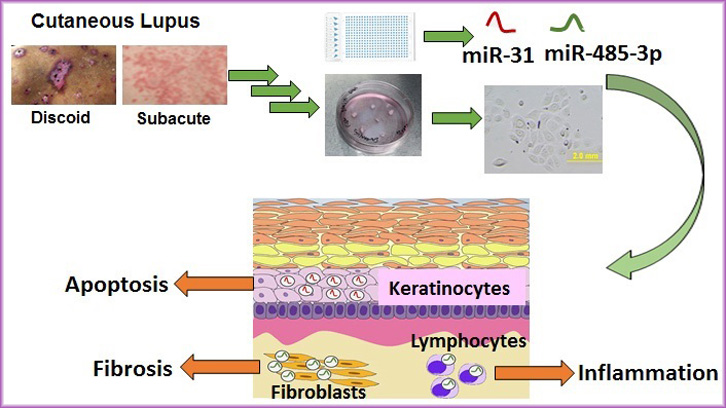MicroRNAs are involved in the cutaneous Lupus disease

Systemic Lupus Erythematosus is an incurable autoimmune chronic disease with a wide range of manifestations that affect the whole body. Patients have a dysregulation of their immune system where the body's defenses produces antibodies against their own cells. One of the most important manifestations is the dermatology, since up to 70% of patients develop it at some point during the course of the disease. Depending on the clinical and histological characteristics of their skin lesions, they can be divided into different subtypes, the most prevalent forms are Discoid Lupus and Subacute Lupus. Although these two clinical subtypes share histological similarities, they clinically differ in their course and prognosis: Lupus Subagut responds better to conventional treatment without leaving residual lesions but Lupus Discoide usually does not respond so well and leaves irreversible scarring lesions. These types of lesions are very annoying as they are visible, in the head, neck and arms, significantly limiting the professional and social life of the patients. It is worth to mention that most of patients are young women, between 20-40 years.
MicroRNAs (miRNAs) are approximately 22 nucleotide RNA molecules that cause translation repression by interacting simultaneously with different target messenger RNA within one cell-type. They play an essential role in the regulatory mechanisms in immune homeostasis and their deregulation has been described in a wide variety of human diseases. In addition, they are mechanisms of early regulation in the cell that allow molecular pathways to be blocked before being fully activated. Consequently, there is currently a growing interest in its role as therapeutic targets.
Thanks to the collaboration of patients with cutaneous lupus from the Vall Hebron Hospital who have provided samples of their skin to perform a screening of microRNAs and also to work with primary cells, it has been shown for the first time that Discoid Lupus has high levels of miR-31 and miR-485-3p which could explain the clinical differences described above. Specifically, myR-31 is present in the Discoid Lupus keratinocytes and its presence favors the apoptosis of these cells, greatly increasing the inflammation process. On the other hand, miR-485-3p is present in lymphocytes and fibroblasts and would play a more relevant role in the perpetuation of inflammation and fibrosis formation. The combination of these two miRNAs explains why the Discoid Lupus does not improve with the conventional treatment and leaves scarring lesions. Currently, the Research Lupus Unit from Vall Hebron Institute Research (VHIR) is working in synthesizing a new drug based on nanoparticles that can be administered topically and can inhibit these two miRNAs. The final objective is finding a new efficacy therapeutically alternative for discoid lupus with no side effects.
Universitat Autònoma de Barcelona
References
Solé, Cristina & Domingo, Sandra & Ferrer, Berta & Moliné, Teresa & Ordi-Ros, Josep & Cortés-Hernández, Josefina. (2018). MicroRNA Expression Profiling Identifies miR-31 and miR-485-3p as Regulators in the Pathogenesis of Discoid Cutaneous Lupus. Journal of Investigative Dermatology. 139. DOI: 10.1016/j.jid.2018.07.026.


